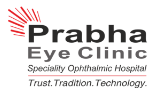Computer Use and Eyes
Instead of spending time outdoors, a great number of people spend the majority of their workday in front of a computer screen. By one estimate, nearly 90 percent of those people working at a video display terminal (VDT) experienced some form of vision problem as a result.

How do you Tell if Your Symptoms are Related to Your Computer Use?
VDT-related symptoms occur some time after you start work. As the workday progresses, your symptoms will become more acute. What are the symptoms that are related to computer use?
- Difficulty focusing after working at a computer, with blurry or double vision.
- Eyestrain or eye fatigue
- Headaches or backaches
- Dry and/or irritated eyes
- Neck stiffness or discomfort
- After-images when looking away from the screen
- Sensitivity to lighting
- Muscle spasms
Are there Environmental Factors that could Affect your symptoms?
Bright lights in your peripheral field of vision could add to discomfort or reduced visual performance. Reflected light on your computer screen can decrease the contrast of screen characters and possibly force you to assume an awkward position to see around the glare.
The location of your screen could cause awkward positioning.
To determine the cause of your symptoms, you should visit your eye care professional. Before going to your appointment, however, take note of the environment in which your symptoms occur and at what times they are greatest. This will aid your doctor greatly in the diagnosis.
If computer Eyestrain is the Diagnosis, there are Simple Methods to Ease the Discomfort:
- Don’t focus on a single object for a prolonged period of time.
- Improve the lighting around your monitor.
- Blink often.
- Frequently close your eyes, then look far into the distance (down a hallway or out a window) every 15-20 minutes to relax them.
- Sit at least 18-28 inches away from the screen.
- Tilt the monitor slightly below eye level
- Keep your screen dust-free to minimize visual interference.
Various clinics of Cornea and Ocular surface
1. Dry Eye Clinic
The health of the ocular surface is maintained by the tear film, normal functioning eyelids, and healthy population of corneal stem cells. The tear glands continuously produce a watery secretion that moistens and lubricates the ocular surface, allowing smooth movement of the eyelids and the eyeball. The tear film also washes away any debris that accumulates on the surface of the eye, and provides a smooth refracting surface of the cornea.
Any deficiency of a stable tear film, directly affects the quality of vision, besides producing a variety of symptoms. These range from dryness, burning sensation, irritation, foreign body sensation, itching, and redness etc. I am sure as you read this section, you will recall experiencing some of these symptoms in the past. Well with the advent of 24 hours television channels, and usage of computers in day to day work, dry eye syndrome has become quite common, and is often referred to as “Computer Vision Syndrome”
While watching television or working long hours on computer, people tend to blink less frequently. This leads to drying of the ocular surface in between blinks, making the surface rough, with resultant symptoms of irritation and burning etc. Moreover sitting in an air conditioned environment leads to faster evaporation and drying of the eyes. Hence it is important to realize this and consciously blink more frequently, or take a break after an hour, and keep the eyes closed to allow the surface to recover.
Dry eye condition, also leads to poor lid hygiene, due to which there may be recurrent episodes of lid margin infections, painful boils in the eye lids. These often tend to recur if the dry eye condition is not properly treated.
But it is extremely important to remember that all dry eyes may not be a result of infrequent blinking. There may be an actual reduction in tear production, leading to all the symptoms described earlier. A proper assessment of the ocular surface status by a well trained corneal surgeon is essential to diagnose the exact etiology, and then provide correct treatment to resolve the same.
Frequently dry eye symptoms may be the first indicator of systemic connective tissue disorders or rheumatoid arthritis, so it is important that your corneal surgeon does a proper evaluation to rule out the same. The routine ophthalmologist (eye specialist), may not be able to assess the surface changes in a detailed manner, as compared to a well trained corneal surgeon.
At the cornea clinic, a detailed history is recorded, followed by clinical tests in a logical sequence, to assess the correct etiology, and severity of the surface damage secondary to dry eye condition.
Proper counselling of the patient is done, following which appropriate dry eye therapy is started. Follow up visits are essential to assess the extent of recovery of the health of the ocular surface. Patients often tend to skip these visits as they get symptomatically better with the medications. Due to this, often it leads to inadequate treatment, and recurrence of symptoms after some time..
Newer medications, such as topical cyclosporine 0.05% can help reduce surface inflammation, & improve the surface sensitivity which tends to improve tear secretion. This is essential to restore the health of the ocular surface and reduce patient symptoms, and dependence on artificial tear drops.
Ocular surface analyser – LIPIVIEW is a diagnostic aid to analyse which layer of the tear film has been affected in causing the dry eye, to study the oil glands of the eye and the tear film quality all in one. This has helped us pickup chronic disturbing ocular surface issues, identify the associated causes and treat them effectively
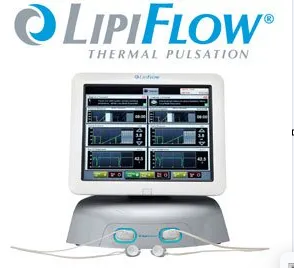
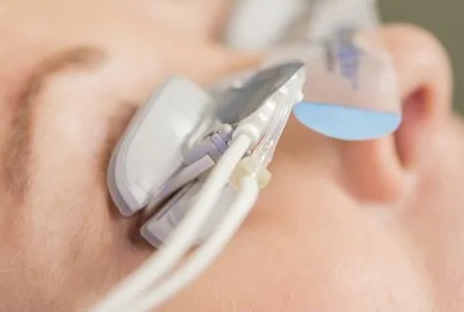
Thermal pulsation therapy – LIPIFLOW It is an in-office procedure to provide controlled heat to the inner eyelid surface and intermittent pressure to the outer eyelid to facilitate release of lipid from the glands .It is and FDA approved treatment for dry eye of evaporative type and promising results have reflected on patients
2. Ocular surface reconstruction surgeries
Various ocular surface conditions and common degenerative conditions of the conjunctiva liek pterygium, pinguecula and cornea like chronic allergic eye disease with giant papillae. Band shaped keratopathy of cornea, Salzman nodular degeneration etc are addressed in this subclinic.
Pterygium is a wing shaped growth of abnormal conjunctiva over the black part of the eye i.e, cornea. This can cause symptoms such as pain, redness, watering and refractive power of the eye may present as a cylindrical error.
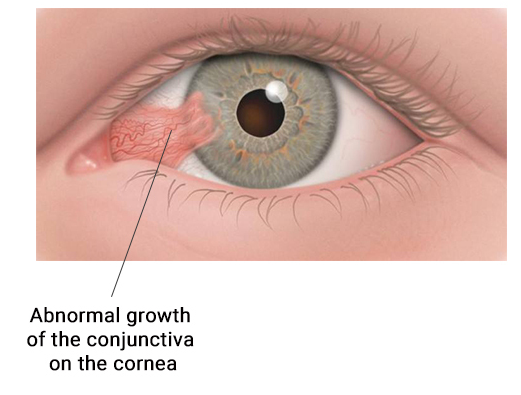
Sutureless Pterygium exicision with Conjunctival autograft or Conjunctival limbal autograft with fibrin glue is performed here with good optimal and cosmetic results
Ocular Surface Inflammation;
Ocular surface inflammation is one of the common presentations in many autoimmune diseases of the eye – like in Rheumatoid arthritis, Steven Johnson syndrome etc. These may present as chronic pain , redness and watering and blurred vision . Treatment in the form of Amniotic membrane transplantation and mucous membrane transplantation is highly essential in such chronic cases and these provide symptomatic relief. Chronic limbal stem cell deficiency as s long term complication of ocular allergy or chemical injury and has fair results with the above mentioned surgical techniques that are being performed here Other surface stabilising procedures like tenons patch graft, papillectomy with cryotherapy in case of intractable ocular allergy are also being done.
3. Specialized Contact lens fitting clinic
For irregular cornea, keratoconus and for therapeutic purpose
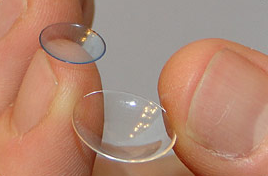
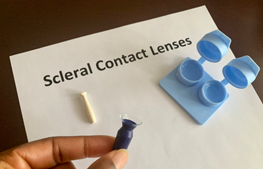
4. Cosmetic corneal tattooing
Some patients secondary to injury to the eye may have irreversible loss of vision and such eyes are amenable to cosmetic tattooing. It is a small OT procedure where liquid tattoo ink is used to make such eyes amenable to good and esthetic appearance


